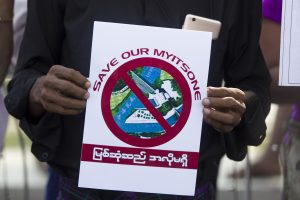Myanmar’s military junta may be considering reviving the China-backed Myitsone Dam project, which was suspended more than a decade ago after protests over its possible environmental and social impact, the Associated Press reported yesterday.
The AP report cited a notice from the military administration’s Information Ministry, published online on Tuesday, which announced the formation of a new leadership team for the Myitsone project, suggesting that the junta is seeking to restart the project.
The $3.6 billion Myitsone project, first agreed by a previous junta in 2006, was slated to be built at the confluence of the Mali and N’Mai rivers, which come together to form the Irrawaddy River in Kachin State. The project was hugely controversial and widely opposed, both because of the likely environmental impacts on the Irrawaddy, the cradle of Myanmar’s pre-modern kingdoms, and because 90 percent of the electricity it generated would have been exported to China. To many in Kachin State and beyond, the project symbolized both the unaccountable nature of military rule in Myanmar and the country’s perceived vassalage to China.
In 2011, President Then Sein, who headed a military-backed government, took the unprecedented step of suspending the dam’s construction, citing the “wishes of the people.” The suspension of the Myitsone dam was followed by a series of then-unthinkable economic and political reforms, which were terminated by the coup d’etat of 2021.
After Aung San Suu Kyi’s National League for Democracy came to office in 2016, China made several attempts to restart the project. In 2018, then-ambassador Hong Liang paid a visit to Kachin State during which he declared that further delays to the Myitsone project could hamper bilateral relations. “If this issue fails to be resolved,” a statement published on the embassy’s Facebook page quoted him as saying, “it will seriously hurt the confidence of Chinese entrepreneurs to invest in Myanmar.”
The notice from the Information Ministry, dated April 24, stated that a board for the Myitsone hydropower project was formed with 11 members from different departments. Aye Kyaw, a deputy minister of the Electricity Ministry, was appointed the board’s leader.
The notice, the AP reported, stated that “the group would conduct research, consider technical solutions and handle public relations for the project in collaboration with the leadership team of China’s SPIC Yunnan International Power Investment company.”
It is hard to know whether this administrative reshuffle reflects a genuine desire to revive the Myitsone dam project, or whether it is merely a sop to China, given the junta’s increasing reliance on its giant northern neighbor. The project has rarely been mentioned since the coup, either by Myanmar junta or Chinese officials, though Senior Gen. Min Aung Hlaing hinted at restarting a number of stalled hydropower projects, including the Myitsone dam, two weeks after the military takeover.
Things have changed a lot in the three years since. Any attempt to restart the Myitsone project would not only face strong public opposition; it would also be severely complicated by the fighting in northern Myanmar, where the Kachin Independence Army (KIA) has made a series of striking gains against the military in recent months. This week, the KIA claimed to have overrun a number of junta outposts in Waingmaw, which lies across the Irrawaddy River from the state capital of Myitkyina, around 20 kilometers south of the Myitsone confluence.
Like many of the junta’s schemes, including its repeatedly deferred plan to hold a multi-party election as a transition back to “civilian” rule, the apparent steps toward reviving the Myitsone project have a fantastical quality that makes it hard to know whether or not to take seriously.

































